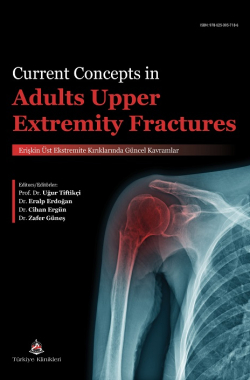REHABILITATION PROTOCOLS FOR FOREARM FRACTURES
Hasan İşsiz
Niğde Ömer Halisdemir Training and Research Hospital, Department of Orthopedics and Traumatology, Niğde, Türkiye
İşsiz H. Rehabilitation Protocols for Forearm Fractures. In: Tiftikçi U, Erdoğan E, Ergün C, Güneş Z, editors. Current Concepts in Adults Upper Extremity Fractures. 1st ed. Ankara: Türkiye Klinikleri; 2025. p.357-361.
ABSTRACT
Positions of the radius and ulna in relation to each other directly affect hand functions. For this reason, forearm diaphyseal fractures are more important than other diaphyseal fractures. Forearm fractures are often seen after traffic accidents, falls from heights, and direct blows. Forearm fractures can be classified according to the fracture site as; forearm double fractures, isolated radius diaphyseal fractures, isolated ulna diaphyseal fractures, Monteggia fractures and Galeazzi fractures. The aim of treating forearm fractures is to prevent functional loss by ensuring appropriate axial and rotational alignment. In fracture rehabilitation; range of motion exercises, simple strengthening exercises, strong strengthening exercises and fracture-specific functional exercises are used. Hydrotherapy, electrical stimulation therapy, fluidotherapy, hot and cold heat therapy can also be applied in fracture rehabilitation. In forearm fracture rehabilitation, full supination, pronation and maximum wrist movements are targeted and muscle strength is increased. Forearm fractures, rehabilitation is expected to last between 12-24 weeks. Period may be longer for specific fractures such as Monteggia and Galeazzi fractures. In accelerated rehabilitation protocols, the rehabilitation program is expected to be completed in the sixth week. Quality of fixation in forearm fractures affects rehabilitation protocols. If rigid fixation is performed, movement and strengthening exercises are started early. In non-rigid fixations and conservative treatments, rehabilitation is delayed until fracture healing occurs.
Keywords: Rehabilitation; Exercise therapy; Radius fractures; Ulna fractures; Monteggia’s fracture; Galeazzi fracture
Kaynak Göster
Referanslar
- Moss JP, Bynum DK. Diaphyseal fractures of the radius and ulna in adults. Hand Clin. 2007;23(2):143-51, v. [Crossref] [PubMed]
- Moritomo H. The distal interosseous membrane: current concepts in wrist anatomy and biomechanics. J Hand Surg Am. 2012;37(7):1501-7. [Crossref] [PubMed]
- Palmer AK, Werner FW. The triangular fibrocartilage complex of the wrist--anatomy and function. J Hand Surg Am. 1981;6(2):153-62. [Crossref] [PubMed]
- Drake R, Vogl AW, Mitchell AWM. Gray's Anatomy for Students E-Book: Elsevier Health Sciences; 2009.
- Moore KL, Dalley AF. Clinically Oriented Anatomy: Lippincott Williams & Wilkins; 1999.
- Rockwood CA, Bucholz RW, Green DP, Court-Brown CM, Heckman JD, Tornetta P. Rockwood and Green's Fractures in Adults: Wolters Kluwer Health/Lippincott Wil İşsiz Rehabilitation Protocols for Forearm Fractures liams & Wilkins; 2010.
- Chung KC, Spilson SV. The frequency and epidemiology of hand and forearm fractures in the United States. J Hand Surg Am. 2001;26(5):908-15. [Crossref] [PubMed]
- Griggs SM, Weiss AP. Bony injuries of the wrist, forearm, and elbow. Clin Sports Med. 1996;15(2):373-400. [Crossref]
- Maculé Beneyto F, Arandes Renú JM, Ferreres Claramunt A, Ramón Soler R. Treatment of Galeazzi fracture-dislocations. J Trauma. 1994;36(3):352-5. [Crossref] [PubMed]
- Schemitsch EH, Richards RR. The effect of malunion on functional outcome after plate fixation of fractures of both bones of the forearm in adults. J Bone Joint Surg Am. 1992;74(7):1068-78. [Crossref]
- Sarmiento A, Ebramzadeh E, Brys D, Tarr R. Angular deformities and forearm function. J Orthop Res. 1992;10(1):121-33. [Crossref] [PubMed]
- Jones JA. Immediate internal fixation of high-energy open forearm fractures. J Orthop Trauma. 1991;5(3):272-9. [Crossref] [PubMed]
- Anderson LD. Compression plate fixation and the effect of different types of internal fixation on fracture healing. Instr Course Lect. 1993;42:3-16; discussion -8.
- Borgquist L, Lindelöw G, Thorngren KG. Costs of hip fracture. Rehabilitation of 180 patients in primary health care. Acta Orthop Scand. 1991;62(1):39-48. [Crossref] [PubMed]
- Braddom RL, Chan L, Harrast MA. Physical Medicine and Rehabilitation: Saunders/Elsevier; 2011.
- Ceder L, Svensson K, Thorngren KG. Statistical prediction of rehabilitation in elderly patients with hip fractures. Clin Orthop Relat Res. 1980(152):185-90. [Crossref]
- Grundnes O, Reikerås O. Effect of physical activity on muscle and bone blood flow after fracture. Exercise and tenotomy studied in rats. Acta Orthop Scand. 1991;62(1):67-9. [Crossref] [PubMed]
- Kellam J, Surgeons AAoO, Association OT. Orthopaedic Knowledge Update Trauma 2: Trauma: American Academy of Orthopaedic Surgeons; 2000.
- Duncan R, Geissler W, Freeland AE, Savoie FH. Immediate internal fixation of open fractures of the diaphysis of the forearm. J Orthop Trauma. 1992;6(1):25-31.
- Crosby CA, Wehbe MA. Early Motion Protocols in Hand and Wrist Rehabilitation. Hand Clinics. 1996;12(1):31-41. [Crossref]
- Chapman MW, Gordon JE, Zissimos AG. Compression-plate fixation of acute fractures of the diaphyses of the radius and ulna. J Bone Joint Surg Am. 1989;71(2):159-69. [Crossref]
- Brehmer JL, Husband JB. Accelerated rehabilitation compared with a standard protocol after distal radial fractures treated with volar open reduction and internal fixation: a prospective, randomized, controlled study. J Bone Joint Surg Am. 2014;96(19):1621-30. [Crossref] [PubMed]
- Solanki PV, Mulgaonkar KP, Rao SA. Effect of early mobilisation on grip strength, pinch strength and work of hand muscles in cases of closed diaphyseal fracture radius-ulna treated with dynamic compression plating. J Postgrad Med. 2000;46(2):84-7.
- Friedrich JB, Shin AY. Management of forearm compartment syndrome. Hand Clin. 2007;23(2):245-54, vii. [Crossref] [PubMed]

